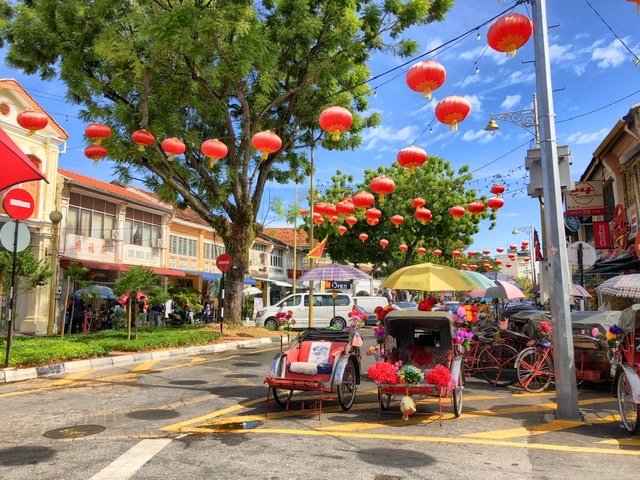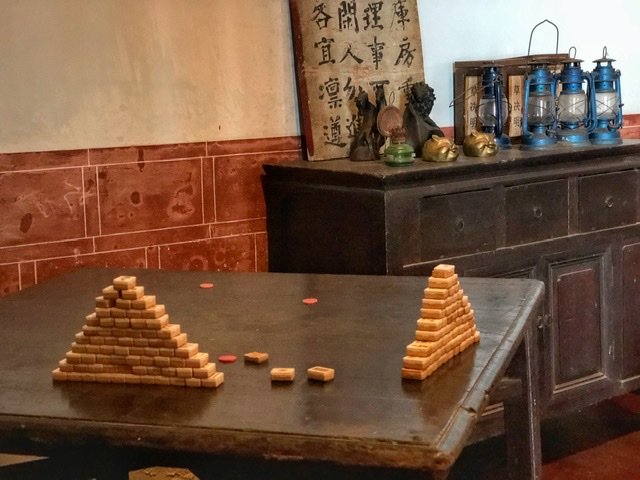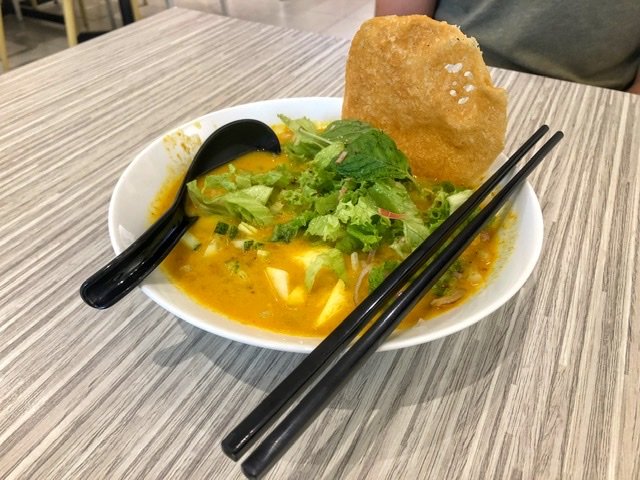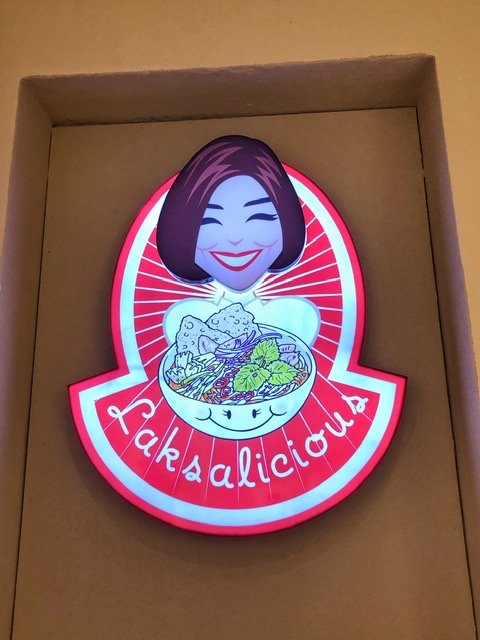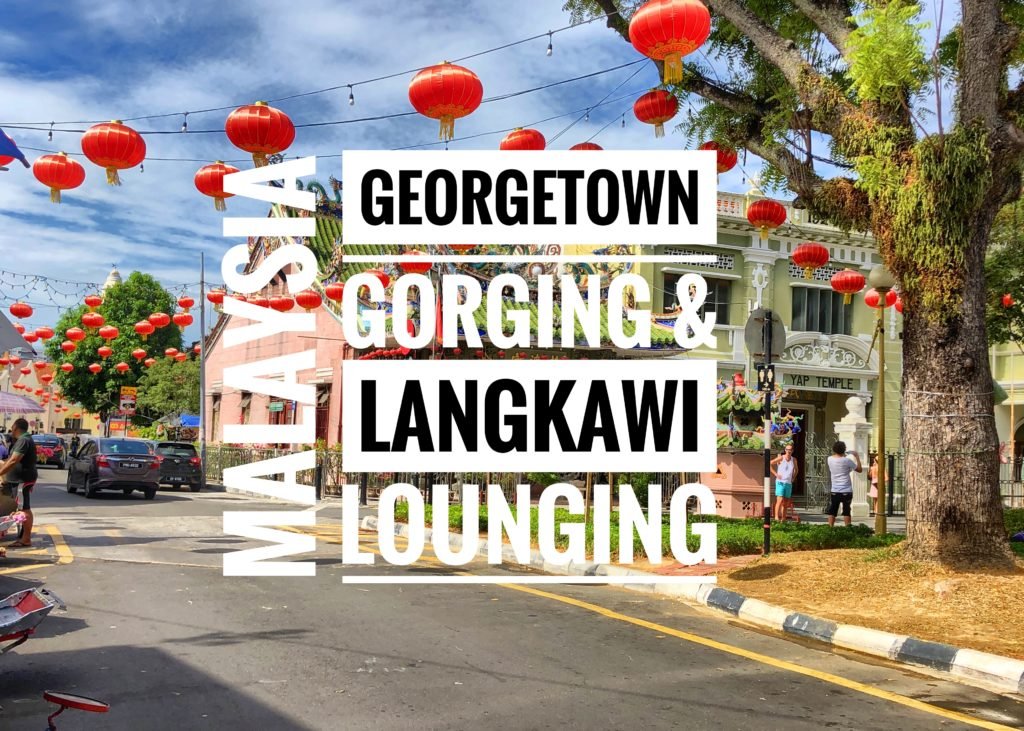
The historic UNESCO center of Georgetown is a wonderland that’s made for strolling, where maps are not required because it’s thrilling to get lost. You will find yourself saying either “wow, or yum” at every turn. It’s a jumble of striking colors, eclectic architecture, interactive street art, and tasty temptations. And unlike our experience in KL, there is little traffic to battle, a free city bus (the CAT), and easy to follow street grid patterns. Highly recommend several days here!
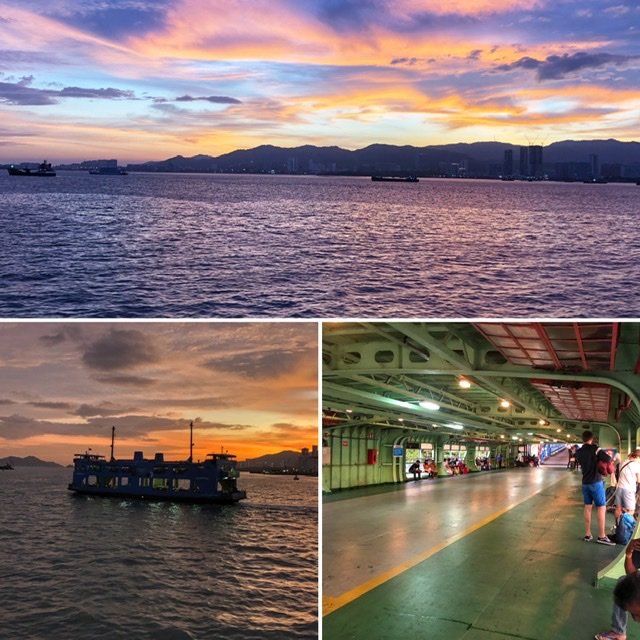
From Kuala Lumpur, we took a 4-hour bus ride ($8.50/each) to the Mrs. Butterworth station in Penang followed by a quick ferry ride ($0.30/each) across to Penang island and Georgetown.
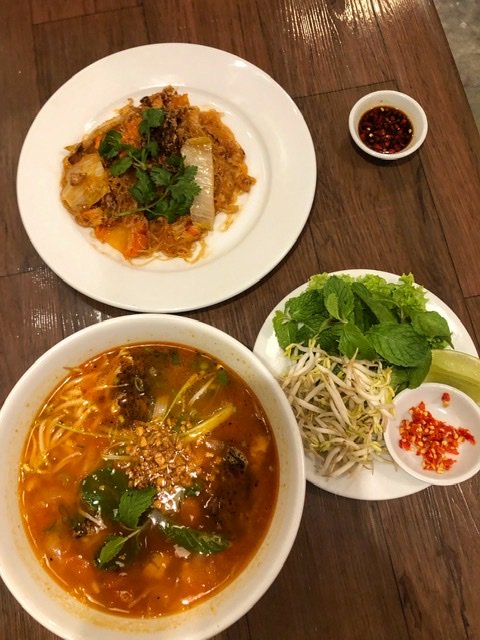
We quickly saw that Georgetown is even more food obsessed than KL with an amazing array of restaurants and hawker stalls. In fact, just moments after stepping off the ferry we plopped ourselves down for Vietnamese food (to train ourselves for future culinary adventures, of course!)
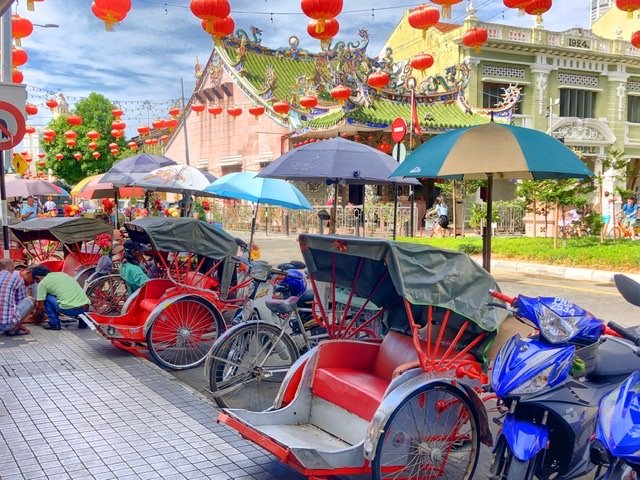
If for whatever reason you should not want to walk, like maybe you ate too much, just hop in a kitschy, yet adorable ‘trishaw’ to tour onward.
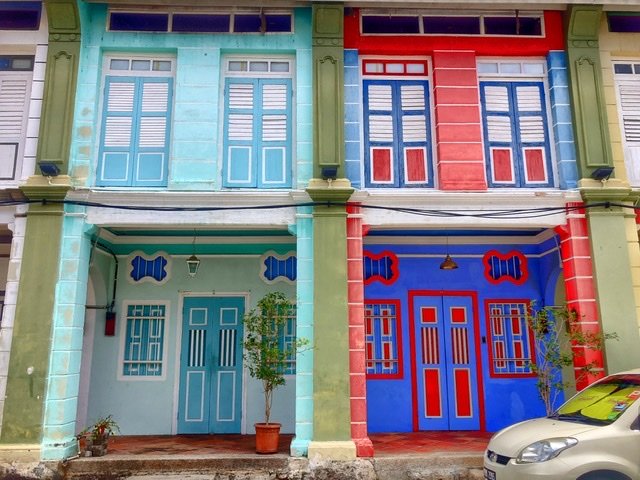
Colorful row houses.
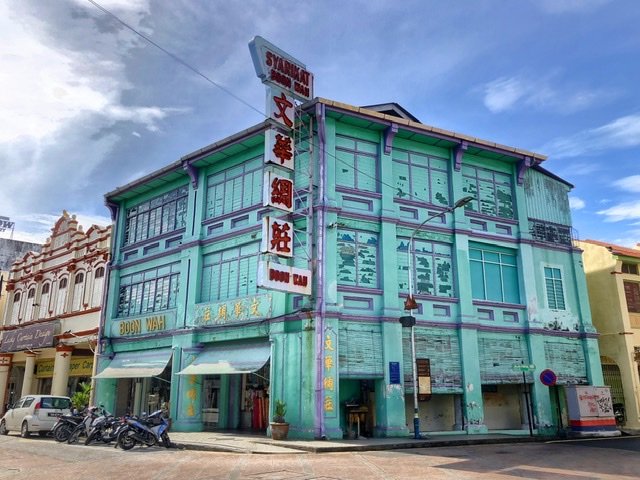
The Malay Chinese and Malay Indian populations (among others) have built up their homes and businesses in Penang for generations and the contributions they have made in the historic Chinatown area are essential to defining the unique character of this lovely city.
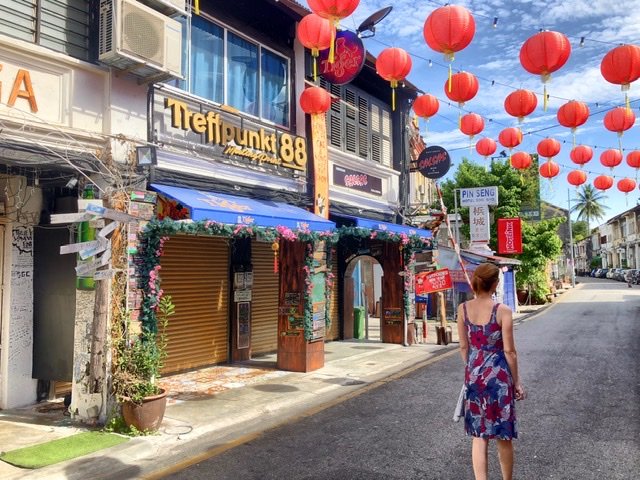
More trishaws line the streets ‘neath rows and rows of Chinese New Year’s lanterns. Until…
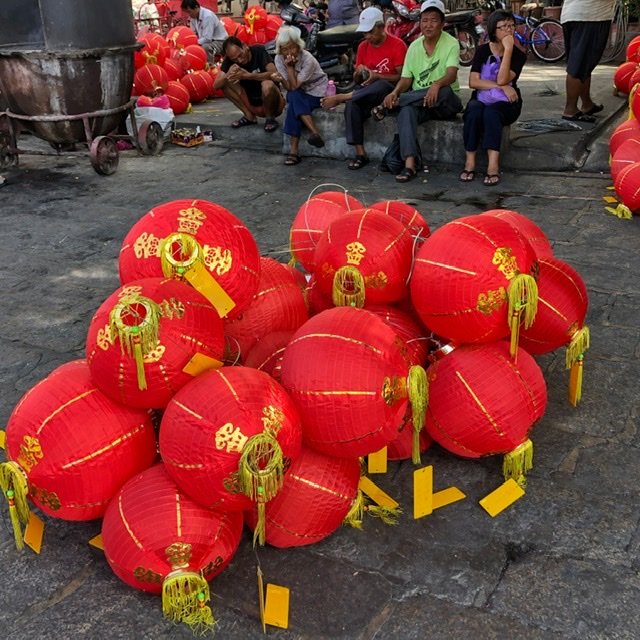

Time for the cleanup crew! After two weeks, Chinese New Year is officially over.

According to our guidebook, the Blue Mansion is one of Penang’s most authentic heritage hotels and blends eastern and western designs with art nouveau stained windows, beautiful tile floors and is a rare surviving example of the electric architectural style preferred by wealthy Straits Chinese.
Unfortunately, the museum staff used the Coronavirus as reason enough to close to tours for “health and safety reasons. Or as the security guard told us, “most of their visitors comes from China.” So, we were left with only the sample pictures of the inside where it looked like Instagram gold. Especially annoying, the attached hotel remained fully open for business, which also intriguingly included mostly “visitors from China.” For the record, other than a few people wearing masks on busses, this was the first and only tourism closure we’ve seen connected to the Corona virus.
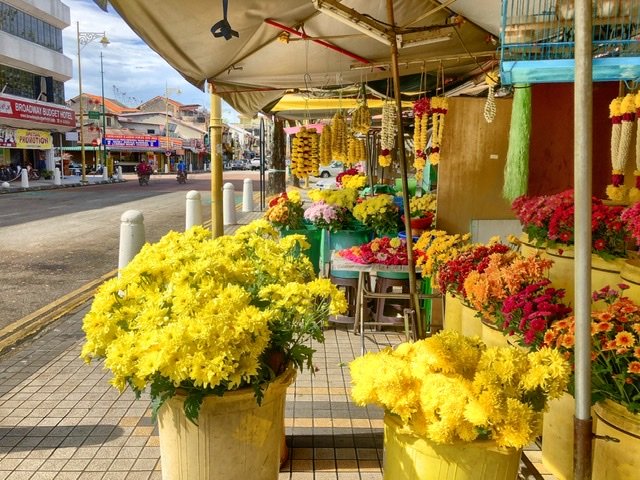
Ah well, off to smell some flowers!

The Khoo Kongsi is an overwhelmingly ostentatious clan complex from 1906 that includes shrines, an opera stage, game rooms and residences. It was one of several unique Chinese clan houses represented and preserved in Penang. This one formerly owned by Khoo Thean Teik, the ringleader of one of these clans from southern China.
The facilities served as embassies of sorts to relocate other family members to Penang and included lodging, employment services and other ways to get members integrated. It had game rooms, relaxation gardens, community rooms, and residences. Now this is a way to treat immigrants! Yes…perhaps a bit over the top, but certainly a special sight to behold!
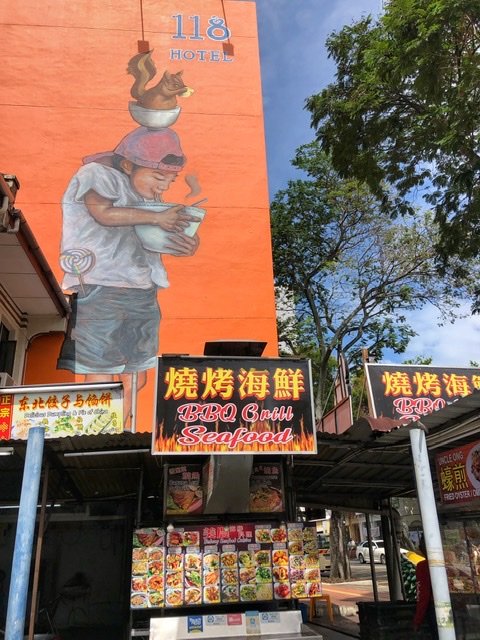
The New Lane Street Hawkers were one of many food stalls we visited during our time in Georgetown.
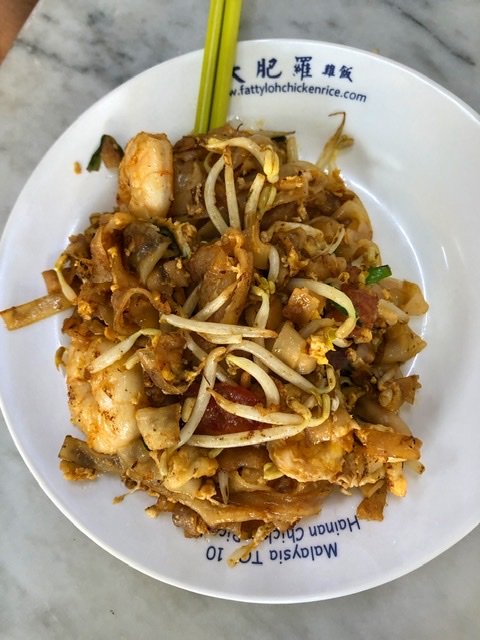
It offers a bit of everything that Penang is famous for including one of favorites Char Koay Tow ?.

The divine toast and jam our hostel provided for breakfast did not really do enough to stimulate our palates in this foodie town, so instead we went out for breakfast at a traditional Roti Canai roadside stand. Roti Canai is an Indian Muslim dish which is an Indian-influenced flatbread served with dhal or other types of curries in a range of sweet or savory variations. In Malaysia, it also often includes chicken. It’s an experienced because you eat a steel table facing the road and are all crammed into one long bench against the wall.

We loved catching little glimpses of life in Malaysia. Stop sign? How do they even fit this! Talk about a language gap
Laksa: one of our favs…a spicy noodle coconut soup with thick wheat noodles, prawns or fish. We had it a restaurant called none other, than Laksalicious.

Malaysian flag: it’s purely coincidental that is looks like the flag of the US. According to Culture Trip: The red and white lines represent the 14 states of Malaysia and the Federal Territories of Kuala Lumpur, Labuan and Putra Jaya. Inside the square, the blue symbolises the harmony of Malaysian people, is a vertical half-moon and a star. The ‘C’-shaped moon signifies Islam. Each point on the 14-point star represents each of the Malaysian states and Federal territory in the same way as the stripes.

The Penang Ice Ball is what happens when a sno cone procreates with ice cream. It’s a scoop of ice cream (we chose coconut) ensconced in a ball of ice with syrupy flavorings including root beer, grape, strawberry and of course, durian poured over the top. Mandy happily holds her ice-ball unaware she’s about to get a mouthful of durian syrup flavoring.

Three other Penang desserts we had to try, including the Trishaw Egg Tart which was a signature product introduced to Panang by Chinese immigrant Ming Xiang Tai using trishaws around the city starting in the 1960’s. The egg tart was an odd but tasty little pastry which was served warm, with a slight eggy taste and a jelly-egg like creamy custard like consistency. Bizarre, but worth trying.
So many fun things to discover in Georgetown on the island of Penang. This city is the epicenter of a cultural crossroads between the two halves of Asia, as well as a great historical trading post between Asia, the Middle East and Europe through its long relationship with the East India Trading Company. These cultures intersecting have created some very unique and special architecture which continued to surprise and reward us as we walked about.
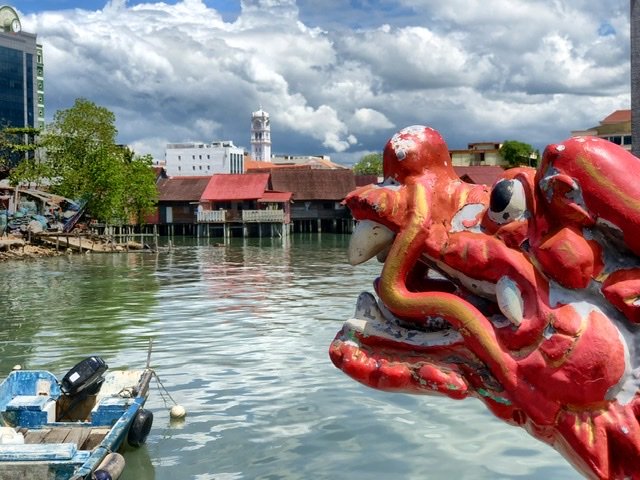
There are six jetties within Georgetown, each named after a Chinese clan and several which still have a community of families living on them. Fun fact: to this day none of these families pay any taxes as they are not living on land.
The most tourist-friendly and amusing jetty to wander onto is the Chew Jetty which has the most stilt-houses, the longest walkway, a temple that is worth checking out, a terrific food court with mouth watering choices, and and plenty of picture perfect moments. You might even get a mischievous little photo bomber!
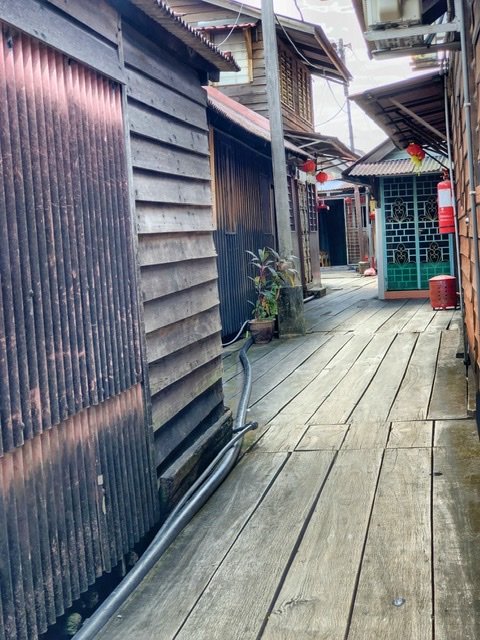
On the jetty planks.
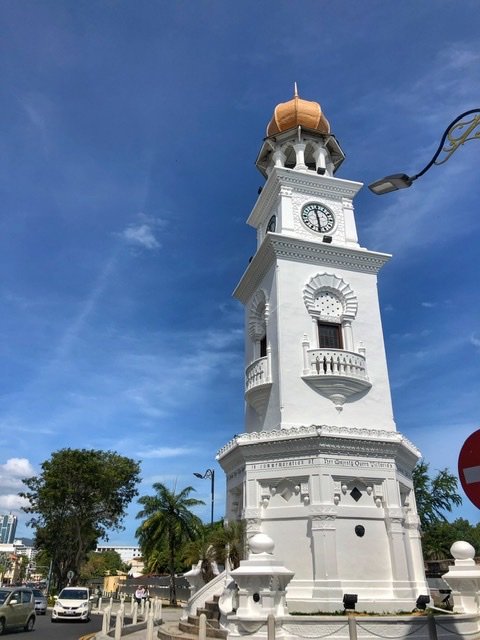
The Queen Victoria Memorial Clock Tower is a testament to Georgetown’s royal British connections. It was built in 1897 in honor of Queen Victoria at a height of 60 feet—one foot to represent each year of her 60-year reign.

Another colonial baroque gem surprising to see in Malaysia is the Wisma Building which serves as the Penang customs house which once housed the former Malaysian Railway Station in 1909. Ironically, however, there were no trains. It was used as a ticketing office to ride on the trains departing from Butterworth, which is a ferry ride away across the Penang Strait.
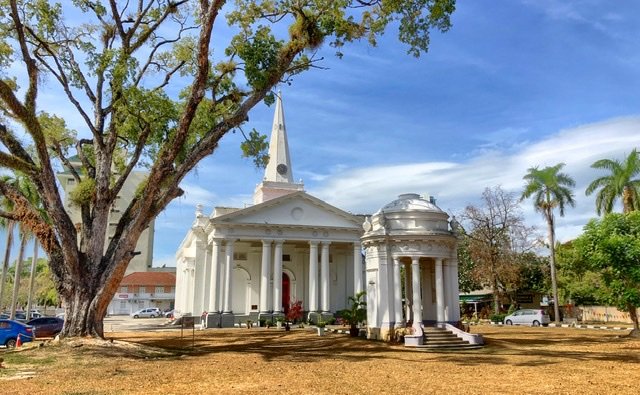
And another. St George’s Anglican Church is one of the oldest Anglican churches in SE Asia, constructed in 1818 at a cost of 60,000 Spanish dollars, which ironically was the same price the British paid for all of Singapore! Heavily damaged in WW2 bombings, the church was reconstructed and reopened in 1948. 9% of Malaysians are Christians.

Not far from the church, is the Kapitan Keling Mosque mosque, which was built in 1801 by Penang’s first Indian Muslim settlers. It’s a stunning work of architectural art, especially at sunset. 61% of Malaysians are Muslims. You will also find Hindu and Buddhist temples scattered throughout Georgetown.

East meets west in stunning mosaic tile floors of the Georgetown passageways with archways bedecked with Chinese lanterns.

The Ren Tang Heritage Inn is a stylish hotel in a 19th century shophouse.
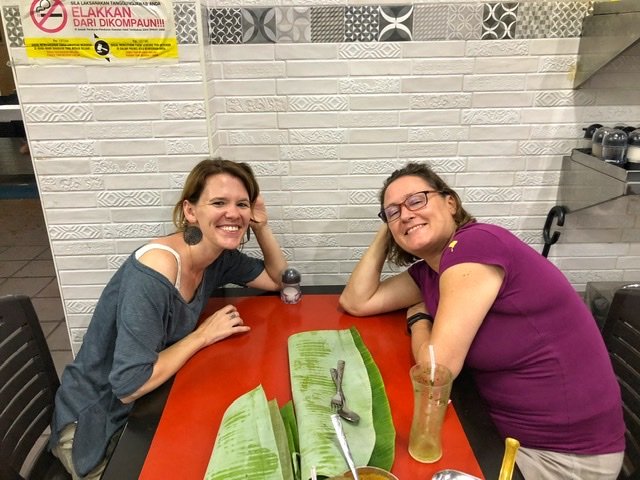
Mandy met her former coworker from her time living in Prague in 2007 here for a drink. We just love having friends to reconnect with from all over the world!
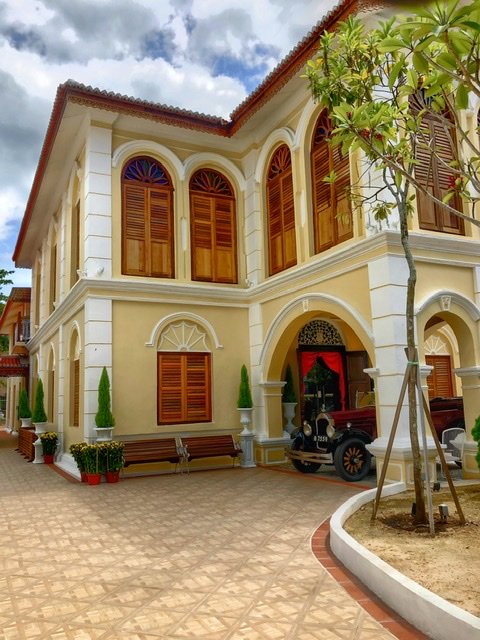
We completely but happily stumbled upon the Suffolk House on our way back to our hostel, it is the only Georgian style mansion remaining in Malaysia. It couldn’t have been more poetic with a Model T style car sitting beneath its porte-cochere. It was built in 1805 to be the main residence of the British governor of Penang. Finding gems like this is why you don’t want to follow a map in Georgetown… just wander!
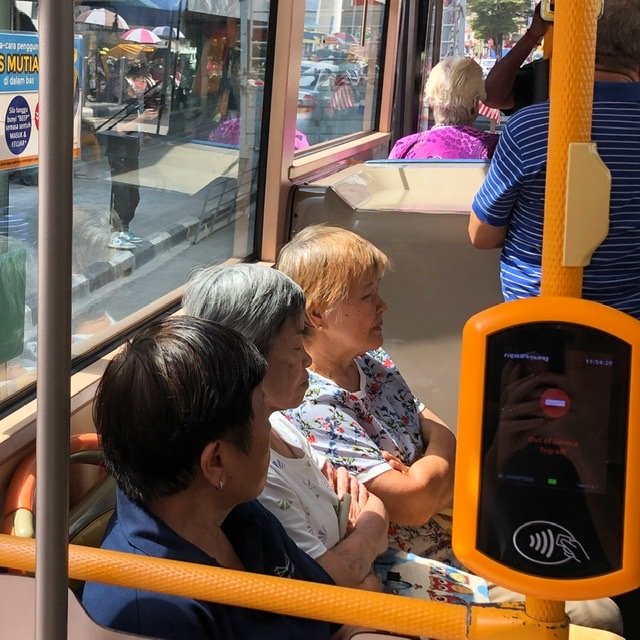
When we weren’t walking in Georgetown, we often hopped on the AMAZING free city CAT bus which came often and conveniently circled the perimeter of the center. Couldn’t help snapping a photo of these three ladies on board one CAT bus, each snoozing and with the exact same haircut, yet each having their own flare with a different color.

Ban Heang is our new favorite store in Malaysia. The entire store is chocked full of different types of biscuits, cookies, savory snacks and other treats. And you can get free samples of…everything you see!! We walked out with some always yummy Penang white coffee and sweet almond biscuits thanks to a skilled sales girl (all still reasonably priced), but you could also experiment with trying some more obscure tastes like pepper biscuits, seaweed cookies, unique fruit teas, fish bites, or durian fruit crisps.
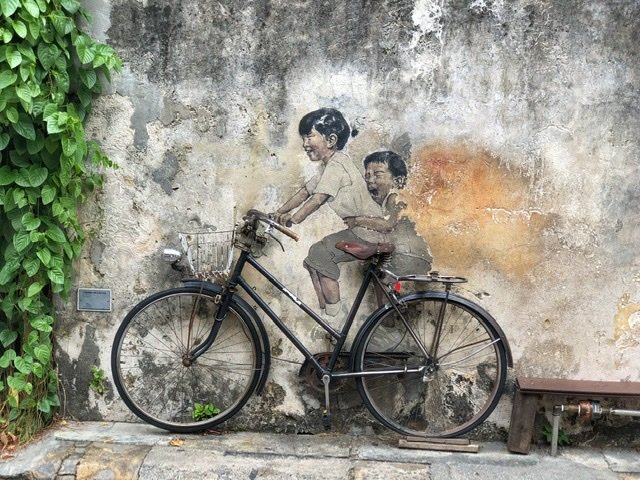
And who could go to Georgetown and not talk about the street art? Many places in the world offer street art, but the 3D Street art in Penang is one-of-a-kind. For starters, it is entertaining and interactive since much of it is randomly spread throughout Georgetown making spotting it a game of hide and seek.
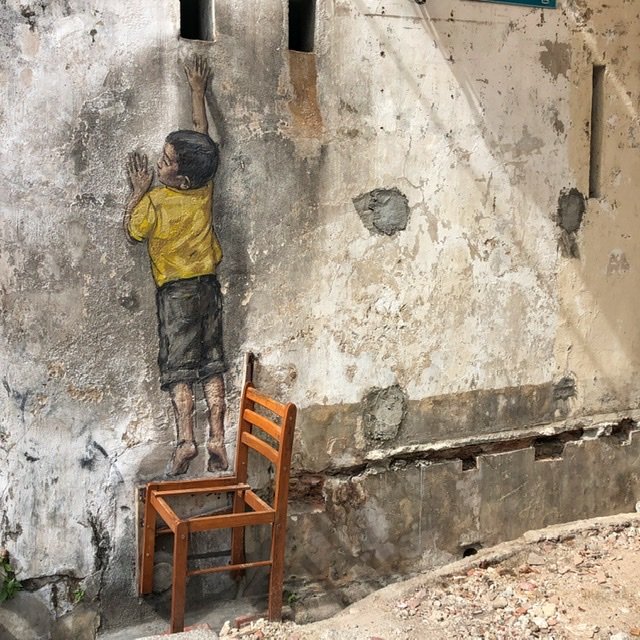
The 3D style of the street art, often showing realistic scenes of mischievous children…
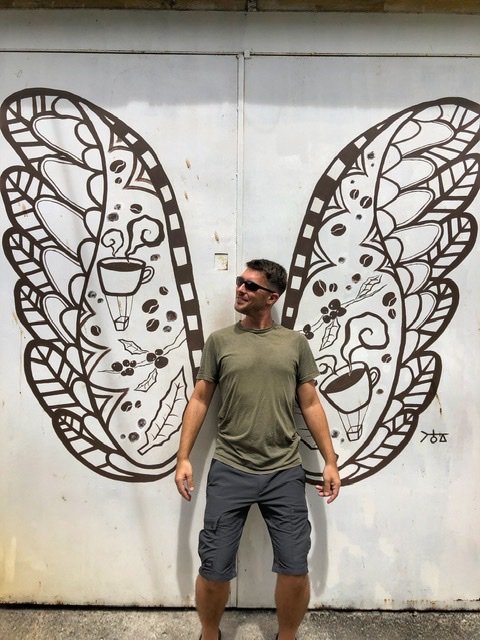
…or mischievous 40-somethings. By the way, Greg realizes these wings are symbolic of angel wings, but he prefers to be called a pterodactyl.
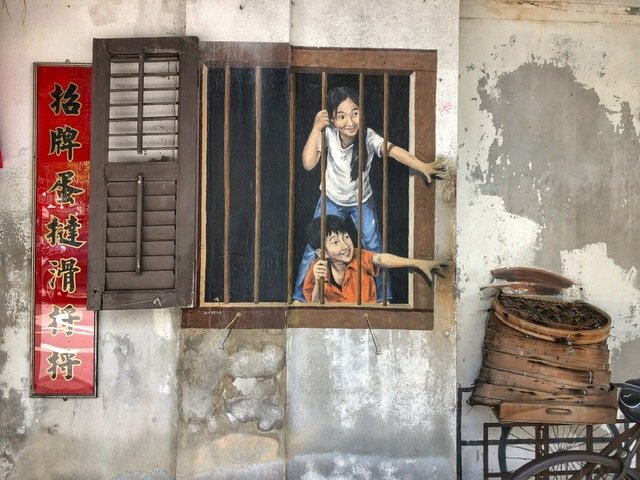
When you’re not playing flying dinosaur, other snapshots from daily life like these kids trying to swipe fruit from a basket through a window introduce fun to the hide-and-seek art tour you accidentally find yourself a part of.
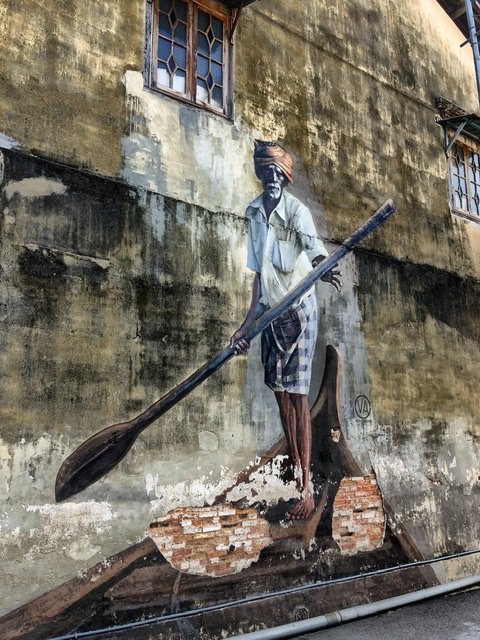
It’s hard not to feel a sense of connectedness with the subjects even though the props are foreign… a fisherman patiently paddling his craft…
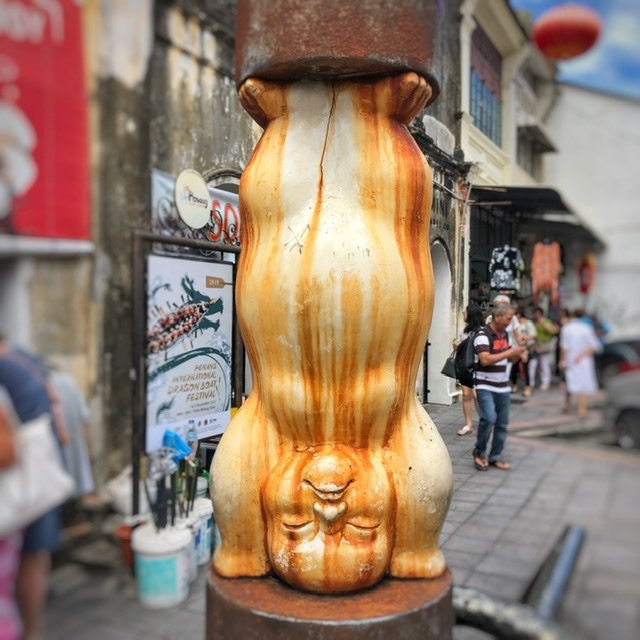
This Buddha in a headstand…
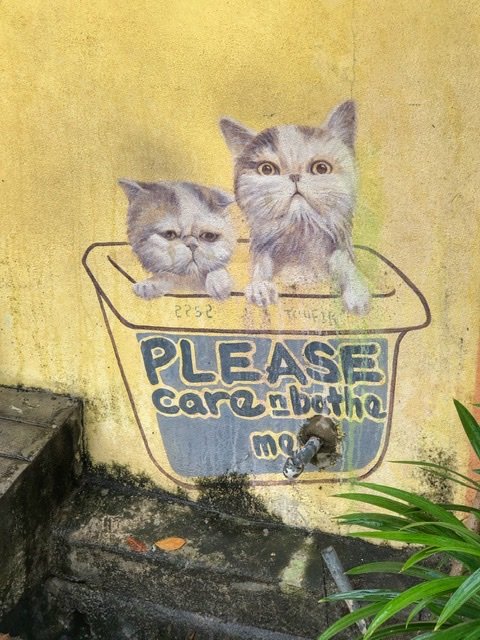
…Or, kittens begging to be picked up and cared fo painted around a water spout.
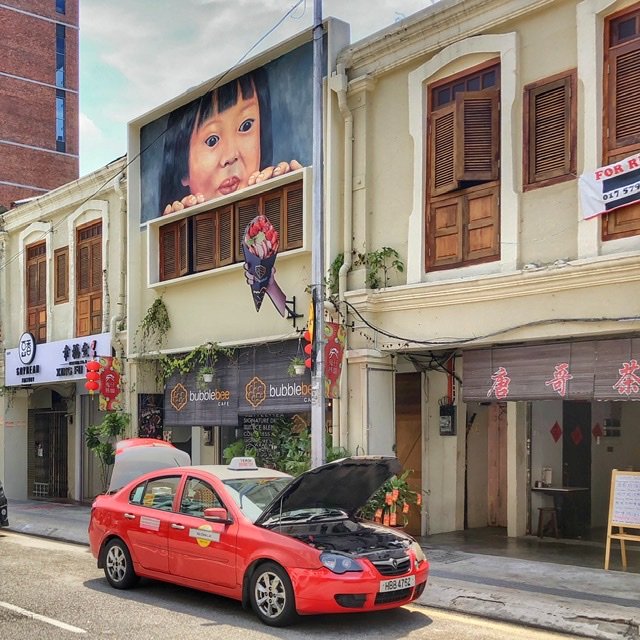
A little girl eyes an ice cream cone from above. (This image was actually in Kuala Lumpur.)
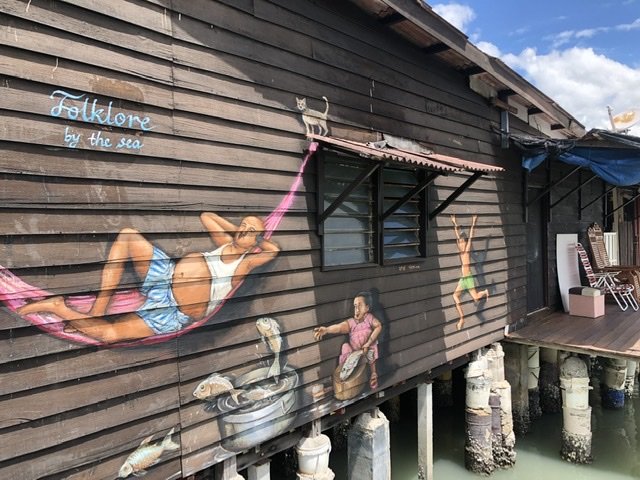
The authenticity and rawness of the art just spoke to us through the faces and innocence.
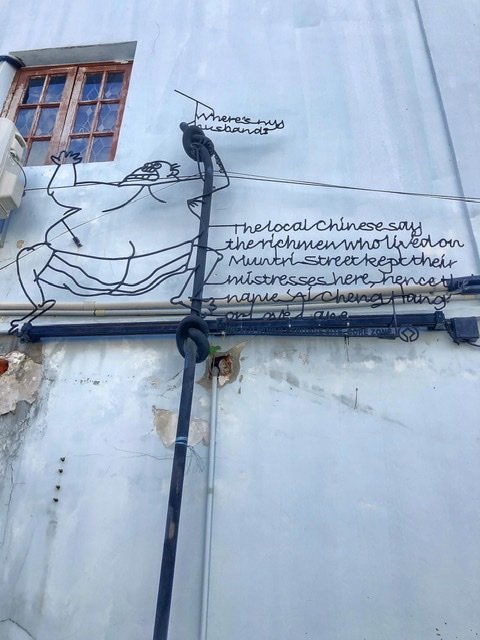
On Lover Lane, you’ll find an example of the unique welded street art as well. Lover Lane is where the local Chinese say the rich men who lived nearby keep their mistresses for an afternoon rendezvous.
There are so many gems throughout Penang, and you really could continue to explore it for days. We were a little bummed to move on. However, the sea was calling, and we couldn’t exactly ignore that!

Langkawi
From Penang, we took a three-hour ferry ride ($18/each) to Langkawi, which is a cluster of 99 islands in the Andaman Sea about 30 km off the mainland coast of northwestern Malaysia and renowned to be a tourist hotspot.
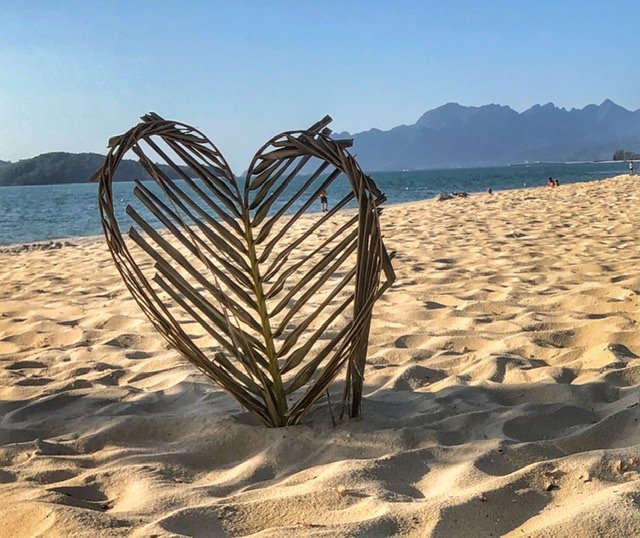
It has some very interesting features including three geo parks, a sky bridge and cable car all which were more than our budget allotted, so instead, we took the opportunity to lay low for a day by the sea and soak in the sun and beach.
Also, Mandy unfortunately had developed a nagging pain in her left hip so it seemed like a good time to try and take it easy, which is also where our experience at TStar Accommodations came in….
After Malaysia, we were off on the ferry again to Ko Lipe in Southern Thailand. However, our time in Malaysia is not complete so our official wrap-up for the country will have to wait. That’s right…we’ll be back to the other side of Malaysia in April as we head into the jungles of Borneo!



